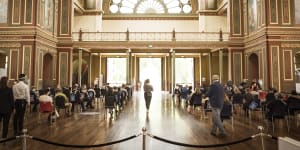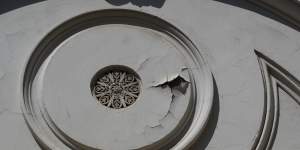But for the distance of time,technology and fashion,the scene was almost the same as that which greeted the 12,000 people who came to see the Duke of York proclaim Australia’s first parliament open.

The Royal Exhibition Building is an integral piece of Melbourne’s history.Chris Hopkins
In 2001,they came to see a building once threatened with demolition – a 1948 Melbourne City Council motion to demolish it failed by a single vote – that stood proudly and as part of a legacy of the city’s great 19th century buildings.
Now,just as it was in 2001 and in 1901,the Royal Exhibition Building is a beautiful,historically important structure to Melbourne and symbolic of the city. It is one of the great exhibition halls of the 19th century. Both the building and the Carlton Gardens,which it inhabits,deserve their UNESCO World Heritage listing. It is arguably as important to Melbourne as the Eiffel Tower – that other “temporary” structure built for the Paris World Fair of 1879 – is to Paris.

Yet today,it sits in a state of serious deterioration. Exterior walls have cracked and are flaking,paint peels from the interior murals,and a number of decorative urns from the parapet have left the building altogether.
Sitting as it now does across the grand pedestrian plaza that separates it from the Melbourne Museum,the Royal Exhibition Building is a magnificent reminder of the great international exhibition halls that proliferated the world throughout the 1800s,notably those in London,Chicago and Barcelona.
Built for the 1880 Melbourne International Exhibition,the Exhibition Building was,perhaps,the boldest expression of Melbourne’s boom time confidence. When it opened on October 1 of that year,70,000 people flocked to see the 32,000 exhibits on show from the Australian colonies and 29 other countries. By the time it closed eight months later,more than a million people had wandered through its halls and annexes.
It's housed a hospital,concerts,exhibitions,the beginning of the Federation and now the Royal Exhibition Building in Melbourne celebrates its 140th birthday.
Designed by Joseph Reed,a Cornish-born Melbourne architect,his plan for the main hall was selected over 17 other proposals and seen as eclectic,to say the least. Made of rendered brick and timber,steel and slate,it combined elements from Byzantine,Romanesque,Lombard and Italian Renaissance styles.
Buildings like this are part of our city’s heritage;they form an integral piece of our collective built and cultural souls.
I walk through the Carlton Gardens every day on my way elsewhere,and I never tire of looking at the Exhibition Building. The contrast with the rigorous geometric forms and bold colours of the Museum is dramatic,but entirely appropriate to share the same ground. Both prime examples of architecture of their time.
No money should be spared in their ongoing,planned and staged conservation and maintenance. Yet,the state government has axed its program funding the conservation of heritage buildings entirely. Perhaps it should speak to the $89 million spent on the recently completed restoration of its own house on Spring Street,which is clearly visible from the observation walk at the base of the Exhibition Building’s dome.

Sections of the Royal Exhibition Building in Melbourne are crumbling and flaking,and in need of urgent restoration.Penny Stephens
It is buildings like this,Parliament House,the State Library of Victoria,the former ICI Building,and former BHP House that attract visitors to Melbourne;that help make it an architecturally important,interesting and diverse city not just for one style or period of architecture,but many.
Investing in maintaining and protecting these assets is as important as removing railway level crossings and building tunnels because without these historical and cultural markers,Melbourne risks losing its unique identity.
Joe Rollo is an architecture writer and editor.
The Opinion newsletter is a weekly wrap of views that will challenge,champion and inform your own. Sign up.